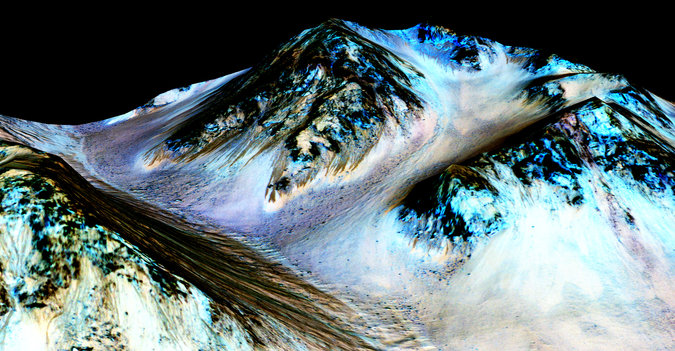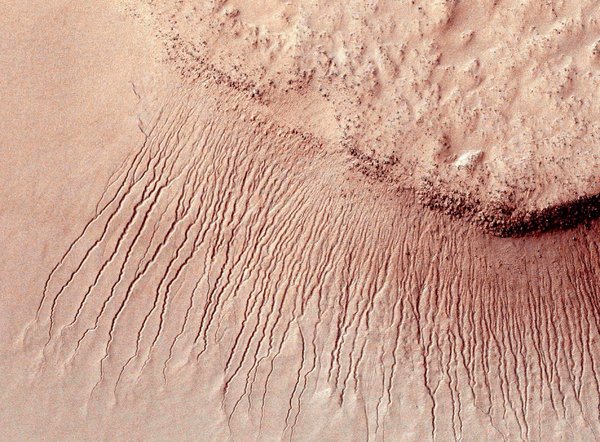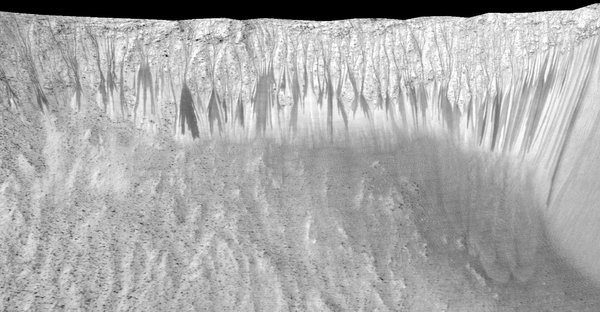The Astronomer Derrick Pitts talks about the big discovery and what it means
On Monday, NASA announced evidence of water on Mars – not water in the distant past, but in the contemporary life of the red planet. “Right now, 140 million miles away, somewhere on the frigid surface of Mars, there is water forming,” the Atlantic reports of an announcement by NASA. “Scientists announced they have strong evidence that briny water flows on the planet, a critical step toward identifying possible life on Mars.”
But what does the new report mean – and not mean? We spoke to Derrick Pitts, the chief astronomer and planetarium director at the Philadelphia science museum the Franklin Institute; he’s also been a guest of Stephen Colbert and and Craig Ferguson. The interview has been lightly edited for clarity.
Let’s start with today’s news about Mars. What does this tell us that we didn’t know?
So what we learned today is that NASA has definitive evidence that there is liquid water acting on the surface of Mars today. They didn’t see water flowing, but they saw, instead, the precipitate of salt that would come out of water when that water evaporates.
For someone like you, who pays attention to the heavens, how shocking was this?
It depends on where you are on this. If you follow the Mars story pretty closely, you’ll find that this is not surprising. It’s not surprising because the actual observation of the features that were revealed today, those pictures have been around for at least five years. If you are a student of geology at all, you could look at those pictures that have been around for five years and say, “A-ha – that looks like evidence of some liquid on the surface, because of the way the wet surface grows in extent in length, then seems to disappear over time. The recurring aspect of this would lead someone familiar with the story to recognize what’s going on here.
The most important thing that’s going on today is that NASA has confirmed that they have a strong enough body of evidence that they feel confident to say that the features are caused by liquid water.
So it’s not another case, which we’ve seen before, announcing that Mars has had water many thousands of years ago. This is seasonal change in the present.
That’s a good way to say it. We can look at the surface features of Mars and easily see that billions of years ago, Mars had more water. I’m telling you, I was looking at satellite pictures of Mars, back in the late 1970s/early ‘80s, and I knew for certain I was seeing fluvial erosion created by water. But there were no landers on the ground. Now we’re much more confident.
There were people – you included – who were pretty confident that there was water on contemporary Mars, not in the distant past… How long ago were you and your colleagues pretty certain of it?
At least five years ago. I’d look and say, “Yeah, OK, it looks to me like there is still some kind of water activity going on now.”
The funny thing about Mars – not the case with the other planets – is that there have been rumors and fantasy and mythology about water and life on Mars going way back. What make Mars special in the imagination?
Mars has been the subject of speculation about life since the early 20th century, since the crude observations made at that time seemed to indicate that there was liquid water flowing on Mars. And that it was probably connected to some civilization…
The “canals” of Mars, right?
Yes the canals of Mars… But nowadays, we actually have scientific evidence of what the surface looks like – not canals. What we were seeing back then were dust storms and things of that sort. What we are seeing now, because of close-up satellite images, indicate the presence of water billions of years ago.








